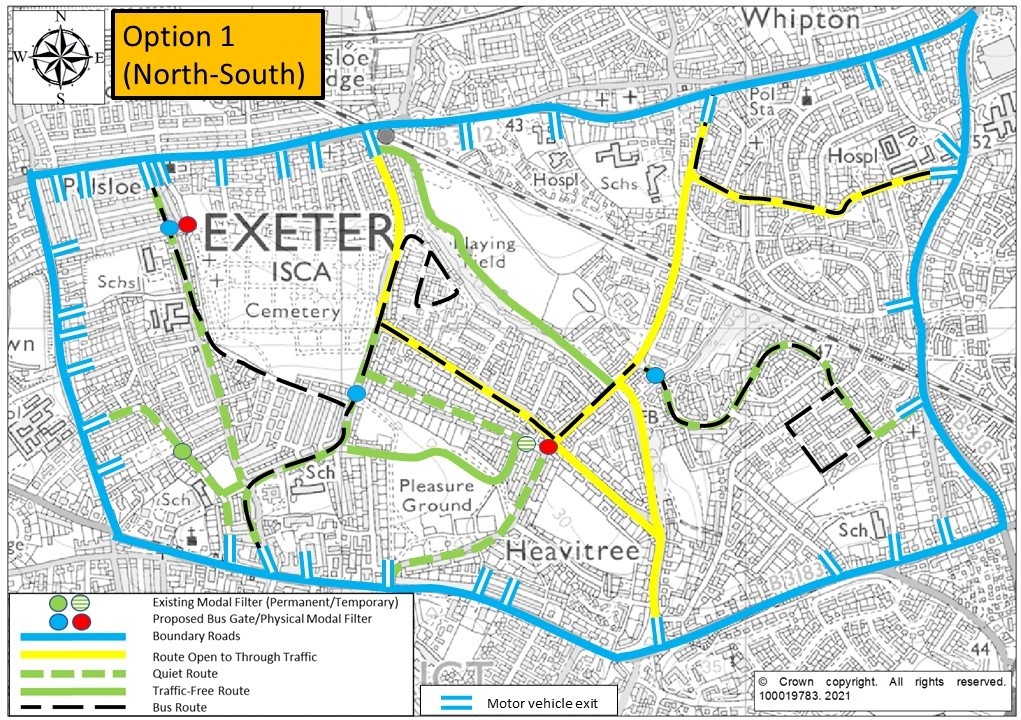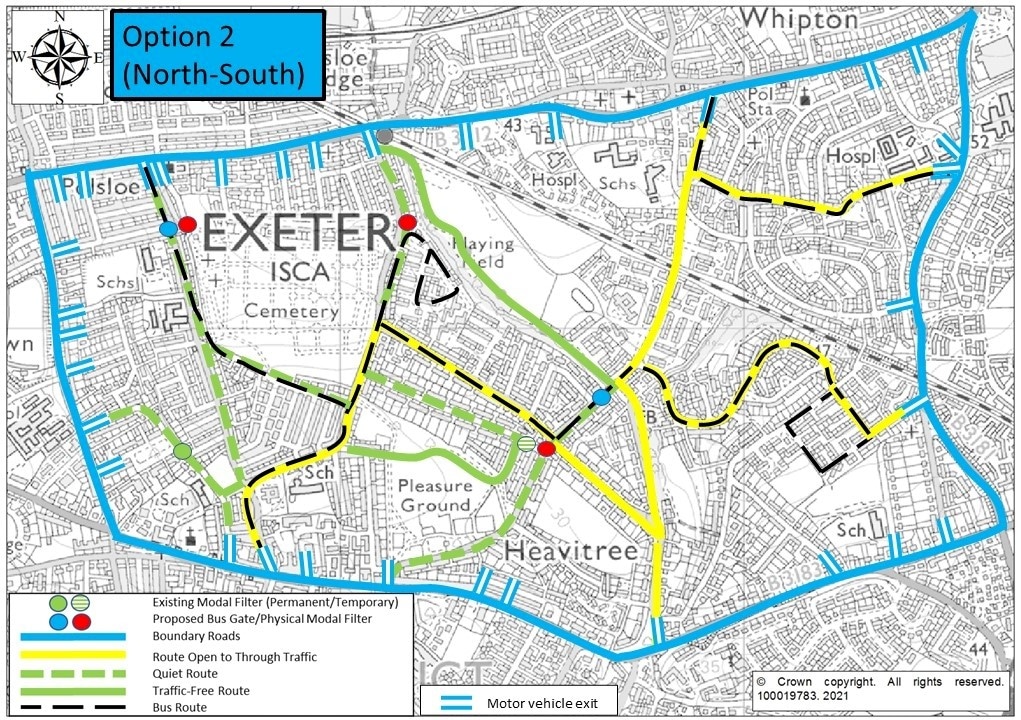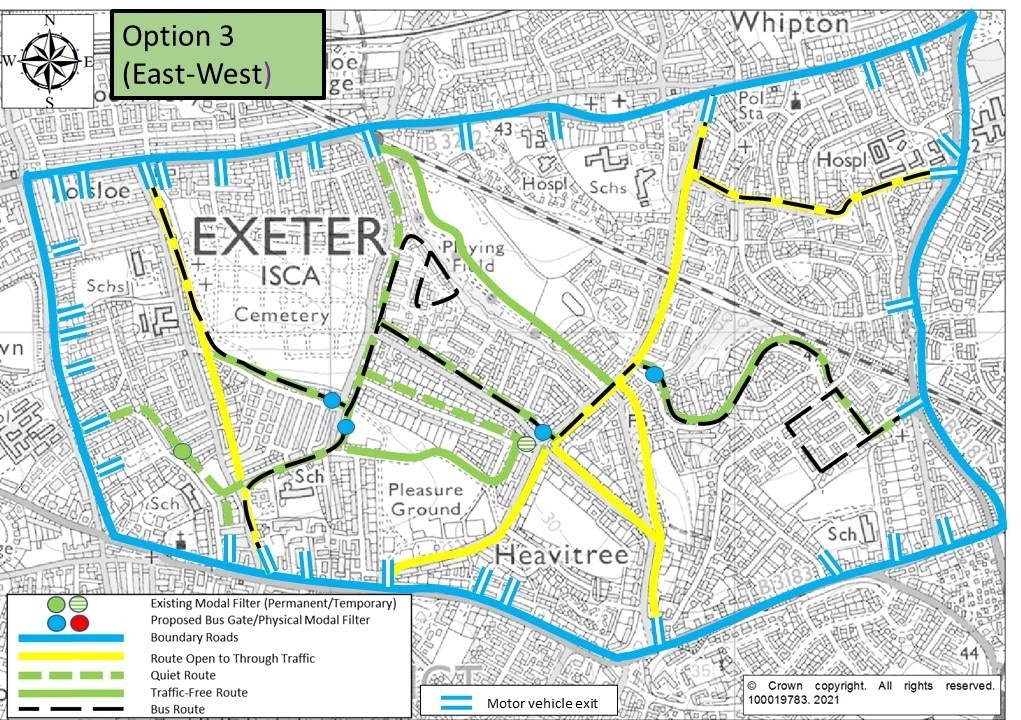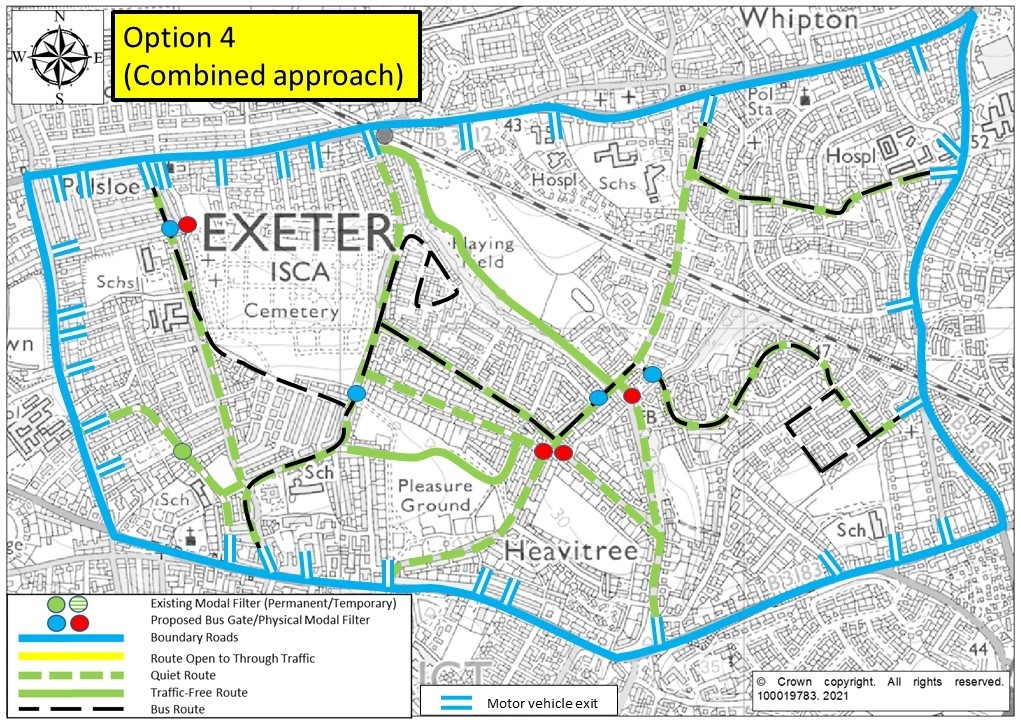Consultation
Heavitree and Whipton (Exeter) local streets consultation
One of the aims in Devon County Council’s Exeter Transport Strategy is for 50% of all Exeter journeys to work and education to be made by foot or bicycle by 2030. Similar aims are shared in Exeter City Council’s Carbon Neutral 2030 plan and Local Delivery Pilot programme which aims to make Exeter the most active city in England.
To help achieve these objectives, we have been engaging with the Whipton and Heavitree community to make the neighbourhood greener, healthier and more attractive.
Phase 1 consultation: November – December 2020
Our first consultation was held in November/ December 2020. 577 people participated in the consultation, with key issues raised including high traffic volumes and/or speeds on Ladysmith Road, Hamlin Lane, Sweetbrier Lane and Thornpark Rise. The findings are summarised in the summary document.
Phase 2 consultation: September – October 2021
Our second consultation was held in September/October 2021. Approximately 1,400 people participated in the consultation. The consultation outcomes are summarised here.
As a result of the Phase 1 Consultation, we prepared a number of options to address the concerns raised. These involved the use of temporary modal filters, which allow the passage of pedestrians, cyclists and buses (where necessary), but prohibit the passage of other vehicular traffic.
The options were designed to reduce the volumes of through traffic using residential roads to travel between the boundary roads (Pinhoe Road, Hill Barton Road, Heavitree Road and Polsloe Road) through Heavitree and Whipton, whilst ensuring all properties remain accessible by motor vehicle, by cycle and on foot.
Option 1 restricts through routes for north-south vehicular traffic:
Option 2 also restricts through routes for north-south traffic, but uses a different arrangement of modal filters:
Option 3 restricts through routes for east-west vehicular traffic:
Option 4 restricts through routes for both north-south and east-west vehicular traffic:
We also consulted on a number of highway changes for Sweetbrier Lane, the roundabout at Sweetbrier Lane and Whipton Lane and a pedestrian and cycle crossing across Whipton Lane, near Vaughan Road.
To help us improve electric vehicle charging facilities in the area, we also invited suggestions for where such facilities are most needed.
Full details of the proposals are available on the consultation webpages, hosted on the PlaceBuilder platform.
This phase of the consultation closed on 7 October 2021.
Consultation event
We held an online consultation webinar on Thursday 16 September from 5:30-7pm.
This included a short presentation of the proposals, followed by a question and answer session. This summary note details the feedback received and queries raised during the question and answer session.
Frequently asked questions
Why is another consultation being held regarding local strees in Heavitree and Whipton?
The phase 1 consultation held in November/December 2020 enabled residents to identify the key issues affecting people’s satisfaction with local streets.
We have used that feedback to create some options to address those concerns. We would now like to receive feedback on those options/interventions which could then be trialled.
What are the objectives of the proposals?
The key objectives of the proposals include:
- creating a nicer environment for walking and cycling
- reducing the perceived negative effects of traffic on the area
- identify where there is demand for electric vehicle charging facilities
These objectives would contribute towards the target in the Exeter Transport Strategy for 50% of journeys within Exeter to be made by foot or cycle by 2030 and to improve air quality in the city.
How have the proposals been developed?
The proposals have been developed in response to the issues raised in the Phase 1 Consultation. In particular, proposals affecting access for vehicular traffic have been focussed on the areas about which most comments were received, namely Ladysmith Road, Hamlin Lane, Sweetbrier Lane and Thornpark Rise.
Recognising that any change may affect another street, the options have been developed as packages of measures that will provide a comprehensive approach across the whole area. Other considerations have included the locations of schools, restricted turning movements on the wider highway network, bus routes and cycle routes.
Why are you proposing modal filters, rather than cycle lanes or other forms of infrastructure?
Modal filters significantly reduce traffic volumes by changing vehicle access, which can reduce through traffic and create quiet streets suitable for most pedestrians and cyclists.
Modal filters are quick to implement and can easily be done as temporary measures. This allows changes to be trialled and adapted, allowing feedback from residents and the impacts to be assessed before decisions are made regarding permanent changes.
What is the difference between a bus gate and a physical modal filter?
A physical modal filter creates a physical barrier to all vehicular traffic, but allows pedestrians and cyclists to pass, whereas bus gates also allow the passage of buses.
Where possible, the proposed modal filters locations have been situated away from bus routes, enabling physical modal filters to be constructed that restrict all vehicular traffic. This is similar to the changes introduced on Homefield Road and Chard Road, Exeter.
However, where bus access will be required, the bus gates would comprise signage indicating ‘No entry (except cycles and buses)’. This is similar to the changes introduced on Wonford Road, Exeter. Failure to comply with these restrictions is an offence, which can be enforced by the police, and members of the public can also submit footage of offences to the police via operation snap.
How have you considered the needs of diabled people when developing these proposals?
For the temporary active travel measures implemented in Exeter in 2020, we undertook Impact Assessments which considered the schemes’ impacts on groups with protected characteristics, including disabled people. These concluded that there was an overall greater benefit in creating a low traffic, safer environment for walking and cycling, which would encourage greater participation in cycling/physical activity amongst young people, older people, women and people with disabilities, and we anticipate any impacts of these proposals would be similar in nature.
Furthermore, respondents are able to indicate their disability status when completing the consultation survey, so we can give particular attention to their views when analysing responses.
Won’t the proposals create more pollution and greenhouse gas emissions, by making residents take longer routes to access their properties?
By making walking and cycling safer and more attractive, it is expected that some people will choose to switch from car to walking or cycling for short trips.
Similar schemes elsewhere in the UK have been shown to reduce total traffic volumes within residential areas, hence it is considered that these proposals would likely reduce traffic in Heavitree and Whipton, reducing emissions.
How would emergency access be affected by the proposals?
The emergency services would be consulted on any changes to vehicle access and all properties within Heavitree and Whipton would remain accessible by emergency services.
There is little evidence that emergency vehicles response times are negatively affected as a result of traffic filters. A research paper by Professor Rachel Aldred was published last year confirming this.
What will be the effect on crime rates in the area?
We have consulted with the Devon and Cornwall Police on the consultation proposals. In London where similar schemes have been implemented, crime rates have reduced by as much as 10%, with even greater reductions in relation to violent offences, as documented in this paper.
Why have issues regarding play and recreation been excluded from this consultation?
Exeter City Council is holding a separate consultation on play and recreation facilities in Heavitree and Whipton.
When would the proposed changes be made?
Changes affecting traffic would be implemented on a temporary basis in Winter 2021/22. The impact of changes would then be monitored and reviewed, and if changes are supported could be considered for permanent changes.
Changes affecting electric vehicle charging would likely be made in phases over the coming years, subject to funding.
How would the proposed changes be funded?
The trials are funded from the Department for Transport Active Travel Fund.
Should any permanent changes be supported, these could be funded from a mixture of Section 106 funding and Devon County Council Local Transport Plan budget.
Why are you prioritising Heavitree and Whipton over other areas of Exeter/Devon?
A number of pop-up changes to support walking and cycling were installed in Summer 2020 following the outbreak of COVID-19. These followed identified strategic cycle routes, including the E3 route which runs through Heavitree and Whipton.
Feedback on the pop-up changes was that more consultation was needed and therefore we have been consulting more widely to understand the key areas of concern for residents before making any further changes in the area.
If the approach and outcome are well received, then we could apply it to other areas.
How can I contact the Exeter Streets team for Heavitree and Whipton?
For any queries regarding Exeter Streets programme, please email:transportplanning@devon.gov.uk
We take accessibility seriously and recognise that some of the information presented in the files available on this page may not be fully accessible to someone using assistive technology such as a screen reader.
If you need guidance or an alternative format, email transportplanning@devon.gov.uk with details of any preferred format and the assistive technology you use.



